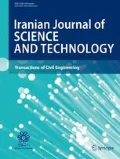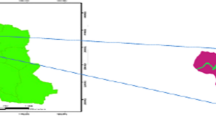Abstract
Nowadays, with the ever-increasing growth of the population and the development of various industries, we are experiencing an increase in man-made leachates such as urban solid wastes, chemicals, and wastewater. Generally, the groundwater in aquifers is contaminated by these pollutants seeping through the above-ground sediment. The vulnerability of groundwater to contaminants can be assessed, which means those areas with lower vulnerability can be distinguished from those areas with high vulnerability. Hydrogeological parameters are presented in a modified DRASTIC method which assesses depth to groundwater surface (D), recharge (R), soil media (S), topography (T), impact of vadose zone (I), conductivity of aquifer, hydraulic capabilities (C), and the effect of land use activity (L). This study aims at zoning the pollution potential of the Mashhad aquifer by using the modified DRASTIC method and GIS to assess the old and new landfill sites. The results show that new and existing (old) landfill sites for solid waste disposal in Mashhad site selections should be closed down due to their location in high vulnerability zones where the risk of groundwater pollution is high.




Similar content being viewed by others
References
Al Yaqout AF, Hamoda MF (2005) Prediction of contaminations migration at unified landfill sites in an arid climate-A case study. Water Soil Air Pollut 162:247–264
Al-Jarrah O, Abu-Qdais H (2006) Municipal solid waste landfill sitting using intelligent system. Waste Manag 26:299–306
Allen A, Brito G, Caetano P, Costa C, Cummins V, Donelly J, Fernades C, Koukoulas S, O’Donell V, Robalo C, Vendas D (2002) Procedure for the location of landfill sites using a GIS model. In: 9th Congress of the international association of engineering geology and the environment, Durban, South Africa. pp 100
Aller L, Bennett T, Lehr J, Petty R, Hackett G (1987) DRASTIC: a standardized system for evaluating groundwater pollution potential using hydro geological setting. US and Environmental Protection Agency, Ado, Oklahoma
Assaf H, Saadeh M (2009) Geostatistical Assessment of Groundwater Nitrate Contamination with reflection on DRASTIC vulnerability assessment: the case of upper Litany Basin, Lebanon. J Water Resour Manag 23(4):775–796
Baghvand A, Nasrabadi T, Nabi Bidhendi GR, Vosoogh A, Karbassi AR, Mehrdadi N (2010) Groundwater quality degradation of an aquifer in Iran central desert. Desalination 260(1–3):264–275
Balis M, Mandylas Ch, Kontos T, Akriotis D, Halvadakis CP (1998) Investigation of suitable areas for the construction of sanitary landfill in Lemnos. Technical Report, Part I, University of the Aegean, Department of Environmental Studies, Waste Management Laboratory/Region of the North Aegean, Mytilene, Lesvos, Greece (in Greek)
Bonham-Carter GF (1994) Geographic information systems for geoscientists. Pergamum (Elsevier Science Ltd.), Elmsford
Charnpratheep K, Zhou Q, Garner B (1997) Preliminary landfill site screening using fuzzy geographical information systems. Waste Manag Res 15:197–215
Chitsazan M, Akhtari Y (2009) A GIS-based DRASTIC model for assessing aquifer vulnerability in Kherran plain, Khuzestan, Iran. Water Resour Manag 23:1137–1155
Civita M (1994) Vulnerability maps of aquifers subjected to pollution: theory and practice. Pitagora Editrice, Bologna (in Italian)
Dorhofer G, Siebert H (1998) The search for landfill sites-requirements and Implementation in Lower Saxony, Germany. Environ Geol 35:55–65
Durmusoglu E, Yilmaz C (2006) Evaluation and temporal variation of raw and pre-treated leachate quality from an active solid waste landfill. Water Soil Air Pollut 171:359–382
Edet AE (2004) Vulnerability evaluation of a coastal plain sand aquifer with a case example from Calabar, southeastern Nigeria. Environ Geol 45:1062–1070
Ehler G, Cowen D, Mackey H (1995)Design and implementation of a spatial decision support system for site selection. In: Proceedings of ESRI international user conference, Palm Springs, CA, USA. pp 100
Fabbri AG, Napolitano P (1995) The use of database management and geographical information systems for aquifer vulnerability analysis. Contribution to the international scientific conference on the occasion of the 50th anniversary of the founding of the Vysoka Skola Banska, Ostrava, Czech Republic
Foster SSD (1998) Groundwater recharge and pollution vulnerability of British aquifers: a critical overview, vol 130. Geological Society Special Publication, London
Fritch TG, McKnight CL, Yelderman JC, Dworkin SI, Arnold JG (2000) A predictive modeling approach to assessing the groundwater pollution susceptibility of the Paluxy Aquifer, Central Texas using a geographic information system. Environ Geol 39(9):1063–1069
Godson RH, Moore J (1995) Subtitle D Groundwater monitoring statistics at a Greenfield Landfill Site in Alabama. In: International environmental conference proceeding, pp 909–915
Halvadakis CP (1993) Municipal solid waste landfill sitting in Greece-the case of the greater hania region, Greece. Ekistics 60(358–359):45–52
Heron G, Bjerg PL, Gravesen P, Ludvigsen L, Christensen TH (1998) Geology and sediment geochemistry of a landfill leachate contaminated aquifer(Grinsted, Denmark). J Contam Hydrol 29:301–317
Herzog M (1999) Suitability analysis decision support system for landfill sitting (and other purposes). In: Proceedings of the ESRI international user conference, San Diego, CA, USA
Ibe KM, Nwankwor GI, Onyekuru S (2001) Assessment of groundwater vulnerability and its application to the development of protection strategy for the water supply aquifer in Owerri, southeastern Nigeria. Environ Monit Assess 67:323–360
Javaheri H, Nasrabadi T, Jafarian MH, Rowshan GR, Khoshnam H (2006) Site selection of municipal solid waste landfills using analytical hierarchy process method in a geographical information technology environment in Giroft, Iran. J Environ Health Sci Eng 3(3):177–184
Kao JJ, Lin HY (1996) Multi factor spatial analysis for Land fill sitting. J Environ Eng 122(10):902–908
Kao JJ, Lin HJ, Chen WY (1997) Network geographic information system for landfill sitting. Waste Manag Res 15:239–253
Kerndorff H, Schleyer R, Milde G, Plumb RH (1992) Geochemistry of groundwater pollutants at German waste disposal sites. In: Lesage S, Jackson RE (eds) Groundwater contamination and analysis at hazardous waste sites. Marcel Dekker, New York, pp 245–272
Komilis DP, Ham RK, Stegmann R (1999) The effect of municipal solid waste pretreatment on landfill behavior: a literature review. Waste Manag Res 17:10–19
Lee S (2003) Evaluation of waste disposal site using the DRASTIC system in Southern Korea. Environ Geol 44:654–664
Lee GF, Jones-Lee A (1993) A groundwater protection strategy for lined landfills. Environ Sci Technol 28(13):584A–585A
Lin H, Kao J (1998) Enhanced spatial model for landfill sitting analysis. J Environ Eng 125:845–851
Lukasheh AF, Droste RL, Warith MA (2001) Review of expert system (ES), geographical information system (GIS), decision support system (DSS) and their application in landfill design and management. Waste Manag Res 19:177–185
Madan KJ, Chowdhury A, Chowdary VM, Peiffer S (2007) Groundwater management and development by integrated remote sensing and geographic information systems: prospects and constraints. Water Resour Manag 21:427–467
Massing H (1994) Impacts of leakage from urban solid waste deposits on groundwater quality. Water Sci Technol 29(1–2):239–244
Mato RRAM (1999) Environmental implications involving the establishment of sanitary landfills in five municipalities in Tanzania: the case of Tanga municipality, Roirces. J Conserv Recycl 25:1–16
Mikac N, Cosovic B, Ahel SA, Toncic Z (1998) Assessment of groundwater contamination in the vicinity of a municipal waste landfill (Zagreb, Croatia). Water Sci Technol 37(8):37–44
Minor D, Jacobs T (1994) Optimal land allocation for solid and hazardous waste landfill sitting. J Environ Eng 120:1095–1108
Napolitano P (1995) GIS for aquifer vulnerability assessment in the Piana Campana, southern Italy, using the DRASTIC and SINTACS methods. MSs Thesis, ITC, Enschede, The Netherlands
Nasrabadi T, Nabi Bidhendi GR, Yavari AR, Mohammadnejad S (2008) Evaluating Citizen attitudes and participation in solid waste management in Tehran, Iran. J Environ Health 71(5):30–33
Nasrabadi T, Baghvand A, Vosoogh A (2015) Groundwater quality determination regarding major anions and cations (case study of an aquifer in the Lut Desert, Iran). Pollution 1:45–54
Pokhrel D, Viraraghavan T (2005) Municipal solid waste management in Nepal: practices and challenges. Waste Manag 25:555–562
Rao KS (1997) Site selection for a landfill. Narosa Publishing House, New Delhi, pp 57–124
Rasapoor M, Nasrabadi T, Kamali M, Hoveidi H (2009) The effects of aeration rate on generated compost quality, using aerated static pile method. Waste Manag 29:570–573
Riediker S, Suter JFM, Giger W (2000) Benzene and naphthalene sulfonates in leachates and plumes of landfills. Water Resour 34(7):2069–2079
Rodney C.S (2006) Groundwater vulnerability to agrochemicals: a GIS-based DRASTIC model Analysis of Carroll Chariton and Saline Countries, Missouri, USA. Electronic Thesis and Dissertation Archives
Schnoor JL, Licht LA, McCutcheon SC, Wolfe NL, Carreira LH (1995) Phytoremediation of organic and nutrient contaminants. Environ Sci Technol 29:318–323
Sener B, Suzen ML, Doyuran V (2006) Landfill site selection by using geographic information systems. Environ Geol 49:376–388
Siddiqui MZ, Everett JW, Vieux BE (1996) Landfill sitting using geographic information systems: a demonstration. J Environ Eng 122(6):515–523
Wang G, Qin L, Li G, Chen L (2009) Landfill site selection using spatial information technologies and AHP: a case study in Beijing, China. J Environ Manage 90:2414–2421
Wen X, Wu J, Si J (2009) A GIS-based DRASTIC model for assessing shallow groundwater vulnerability in Zhangye Basin, northwestern China. Environ Geol 57:1435–1442
Yagoub M, Buyong T (1998) GIS applications for dumping site selection. In: Proceedings of the ESRI international user conference, San Diego, CA, USA. pp. 107
Yenigul BN, Elfeki AM, Gehrels JC, Van den C, Hensbergen AT, Dekking F (2005) Reliability assessment of groundwater monitoring networks at landfill sites. J Hydrol 308:1–17
Yesilnacar MI, Cetin H (2005) Site selection for hazardous wastes: a case study from the GAP area, Turkey. Eng Geol 81:371–388
Author information
Authors and Affiliations
Corresponding author
Rights and permissions
About this article
Cite this article
Vosoogh, A., Baghvand, A., Karbassi, A. et al. Landfill Site Selection Using Pollution Potential Zoning of Aquifers by Modified DRASTIC Method: Case Study in Northeast Iran. Iran J Sci Technol Trans Civ Eng 41, 229–239 (2017). https://doi.org/10.1007/s40996-017-0054-3
Received:
Accepted:
Published:
Issue Date:
DOI: https://doi.org/10.1007/s40996-017-0054-3




